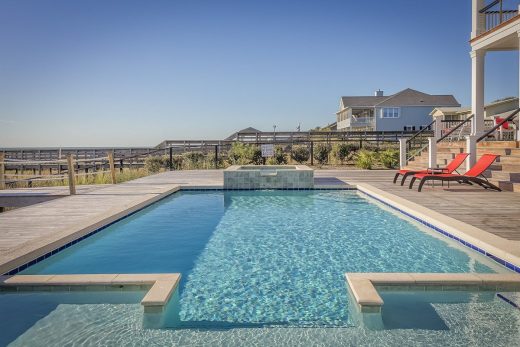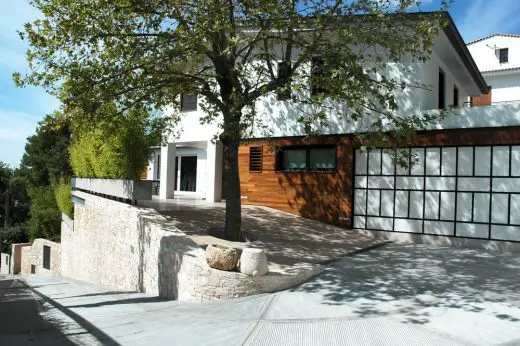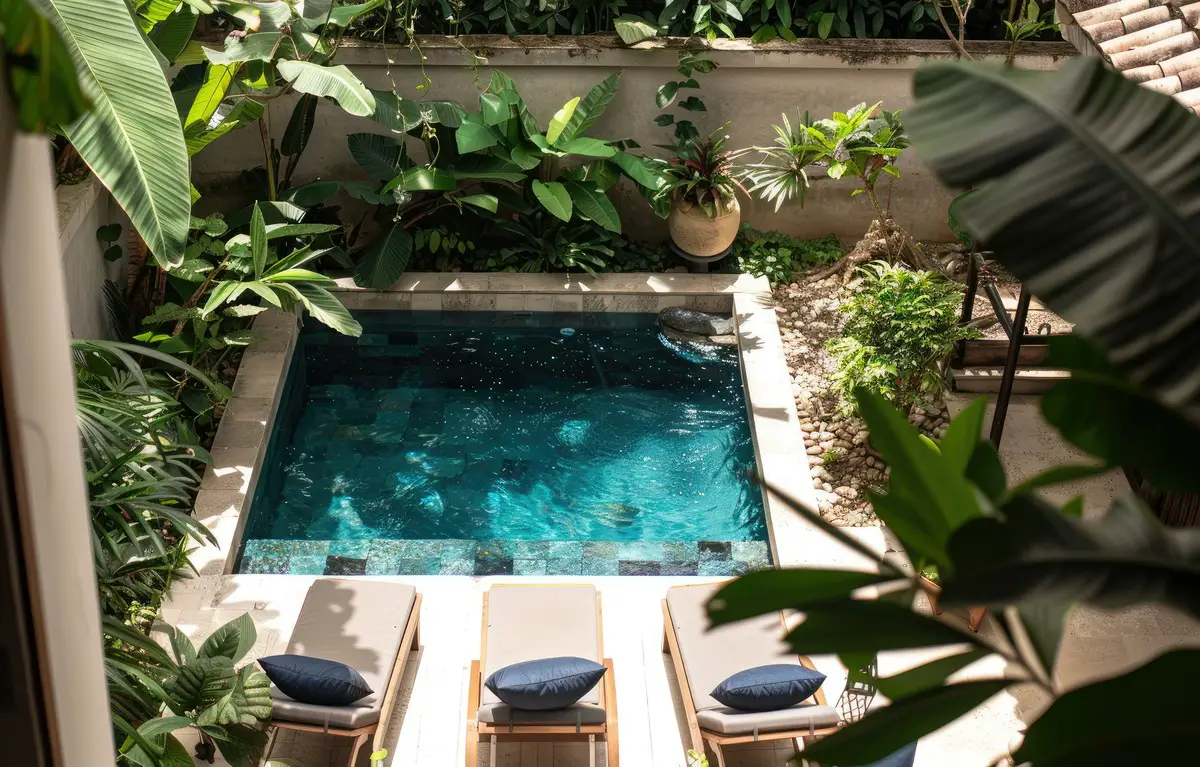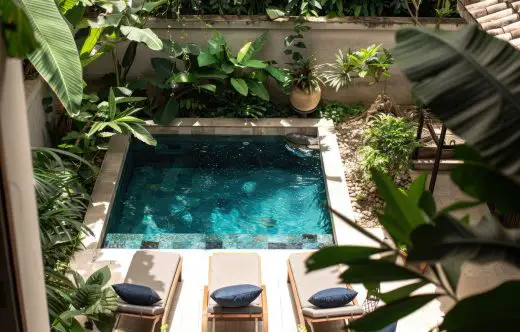Innovative architecture: Integrating organic swimming pools in modern designs, Home deck advice
Innovative Architecture: Integrating Organic Swimming Pools In Modern Designs
25 June 2024
Homeowners and architects are increasingly drawn to organic swimming pools, an appealing alternative to traditional chlorine-filled pools. These chemical-free havens provide a refreshing escape and integrate seamlessly with modern architectural designs. This article delves into the rising popularity of organic swimming pools, their distinct benefits, and their impact on contemporary home landscapes. From improving aesthetics to supporting sustainability, organic pools are significantly influencing the realm of innovative design.
The Essence of Organic Swimming Pools
Organic swimming pools, often called natural swimming pools or eco-pools, are chemical-free and mimic the natural ecosystem of a pond or lake. Instead of using chlorine or other harsh chemicals to keep the water clean, they rely on natural filtration systems. Many people who have these use poolside turf instead of having a poolside yard and make use of large decorative pots for plants.
Natural Filtration
The secret to an organic pool’s crystal-clear water is its biological filter. This usually includes a separate ‘regeneration zone’ with aquatic plants and helpful bacteria. As the water flows through this area, the plants and bacteria team up to break down organic matter and pollutants, keeping the water clean and pure.
Comparing Organic vs. Traditional Pools
Organic pools are a whole different vibe compared to traditional chlorinated pools. Instead of needing regular chemical treatments to stay clean, organic pools use natural processes to keep the water clear. This means no harsh chemicals and a more eco-friendly, sustainable way to enjoy swimming. We suggest you use Pool Cover UK to protecting your swimming space.
Plus, organic pools are much kinder to your skin and eyes since you’re not dealing with the irritants found in chlorinated water. On top of that, they often need less maintenance over time because the natural filtration system handles most of the work.
Practical Applications
You can design a natural swimming pool to match all sorts of styles and settings. Some people go for a natural look with rocks, waterfalls, and lots of greenery around the pool. Others prefer a modern vibe with clean lines and minimalist features. The options are endless, and the end result is always a beautiful, eco-friendly, and welcoming oasis.
Example: A Modern Oasis
Picture a sleek, rectangular organic pool tucked into the minimalist landscaping of a modern home. Smooth stone edges frame the crystal-clear water, with a small waterfall cascading in from a living wall covered in vibrant greenery. Submerged aquatic plants gently sway in the water, adding natural beauty and keeping the pool pure and inviting.
Architectural Integration
Integrating organic swimming pools into contemporary architectural designs enhances the visual appeal of properties while significantly improving their environmental sustainability. This detailed examination explores how architects can effectively incorporate these natural features into their projects.
Visual Harmony with Landscape: Organic pools are crafted to integrate smoothly with their surroundings. Architects can achieve this by utilizing natural stones for the pool borders and choosing aquatic plants that complement the garden’s existing flora. This approach fosters a sense of visual continuity that appears both deliberate and welcoming.
Incorporating Sustainable Materials: The use of local, sustainable materials in the construction of organic pools is crucial. For example, using reclaimed wood for decking and local stones can reduce the environmental impact while maintaining a modern and elegant look.
Spatial Considerations: Thoughtful placement of an organic pool can enhance the functionality of outdoor spaces. Positioning the pool to serve as the focal point of leisure areas, or as a tranquil visual backdrop visible from inside the house, maximizes its impact on the living space.
Innovative Water Features: Beyond the pool itself, incorporating waterfalls or fountains that use the circulating pool water can add dynamic elements to the design. These features not only create soothing sounds but also assist in the aeration of the pool, contributing to clearer water without chemical use.
Lighting and Accessibility: Strategic lighting can enhance the natural beauty of the pool at night, highlighting the water’s reflective properties and the surrounding plants. Additionally, designing easy access through gentle, non-slip pathways ensures that the integration is as practical as it is beautiful.
Design and Construction Challenges
The design and construction of organic swimming pools present unique technical challenges, which require innovative solutions. Here’s an exploration of these issues and how industry professionals address them.
Managing Water Filtration Naturally: Unlike traditional pools, organic pools rely on biological filtration. Achieving this involves configuring a balanced ecosystem within the pool area, where plants and microorganisms clean the water. Architects and engineers often integrate a separate regeneration zone, filled with specific aquatic plants that naturally clean the water, ensuring clarity and hygiene without chemicals.
Structural Integrity Concerns: Organic pools can have irregular shapes and require different construction techniques than standard pools. Builders often use more flexible materials that adapt to natural ground movements. The use of reinforced liners and specialized underlays ensures that the pool maintains its integrity over time despite its organic shape.
Water Circulation Systems: Effective water circulation is vital for maintaining water quality in organic pools. This challenge is met by installing strategically placed inlets and outlets that ensure water flows throughout the pool, mimicking natural water bodies. Innovative pump systems designed for low energy consumption also help maintain circulation without disrupting the natural look and feel of the pool.
Temperature Regulation: Maintaining a comfortable water temperature in organic pools can be challenging, especially in cooler climates. Solutions include using solar Pool Covers or installing geothermal heating systems, which are sustainable and maintain the pool’s eco-friendly credentials.
Conclusion
The integration of organic swimming pools into modern architectural designs and represents a forward-thinking approach to both aesthetics and sustainability. These pools provide a harmonious blend with natural landscapes, enhance property values, and promote healthier environments without relying on harsh chemicals.
The challenges in designing and constructing these features encourage continuous innovation in architecture and building practices, ensuring that each outdoor upgrade not only meets specific client needs but also contributes positively to the environment. As sustainable practices gain momentum in the architecture field, organic pools stand out as both practical and sophisticated alternatives to traditional swimming pools.
Comments on this guide to Innovative Architecture: Integrating Organic Swimming Pools In Modern Designs article are welcome.
Swimming Pools
Swimming Pool Design Articles
Swimming Pool Designs
Swimming Pool Building Designs
What do you need to swim in a pool
Important purchases for your new swimming pool
How to ensure your family swimming pool is child-friendly

Swimming Pool in Belgium

photo : Frederik Vercruysse
Thermal Baths in Bad Ems Building , Germany

photo © David Matthiessen
Family House Revision & Pool for Art, Athens, Greece
Architects: Eleni Kostika Architecture

photograph © Alexandros Tsonidis
Family House Revision & Pool for Art
Property Articles
Comments / photos for the Innovative Architecture: Integrating Organic Swimming Pools In Modern Designs page welcome







